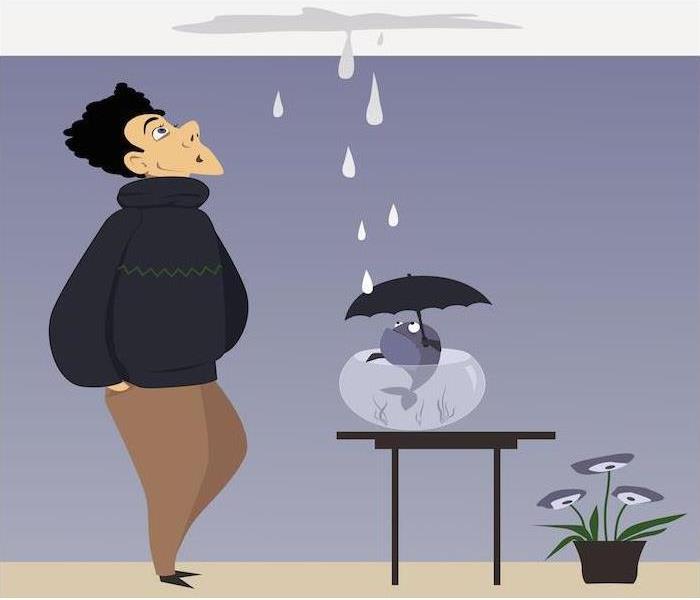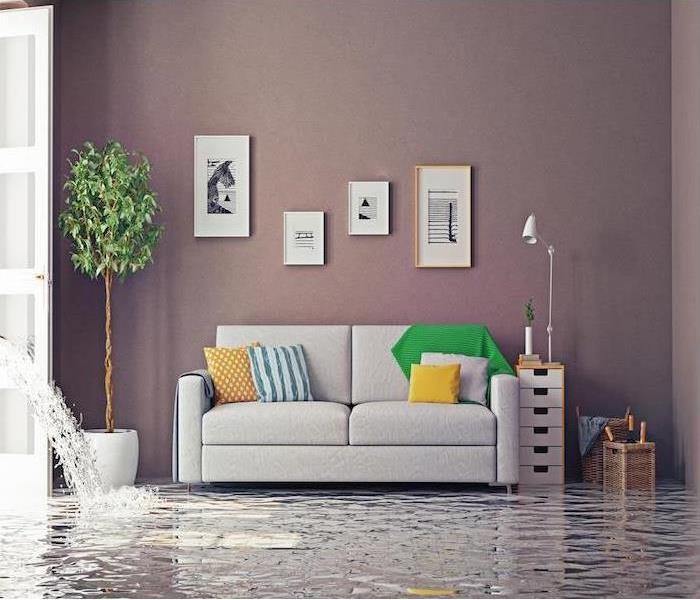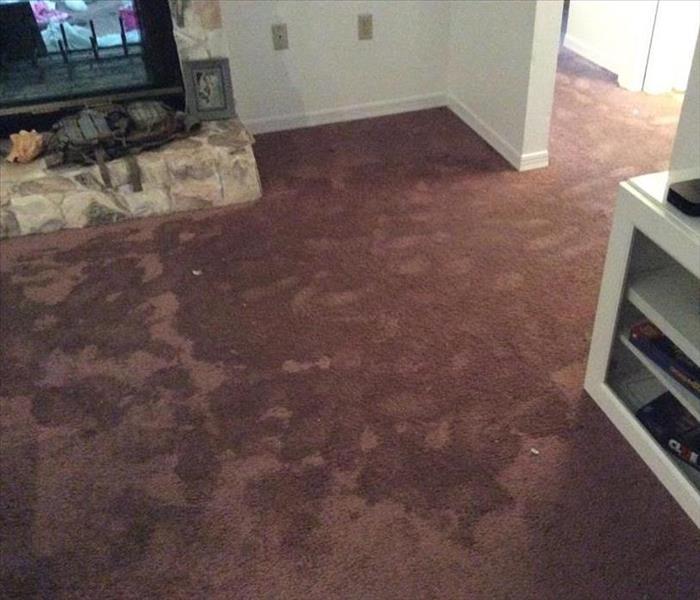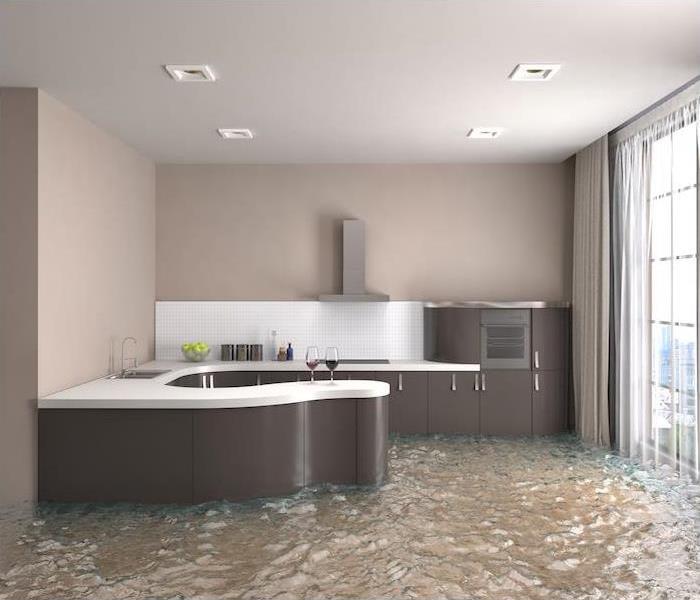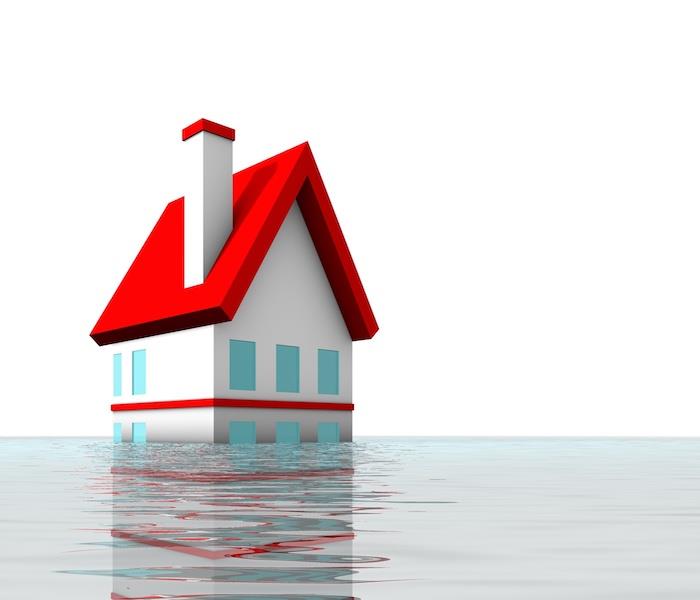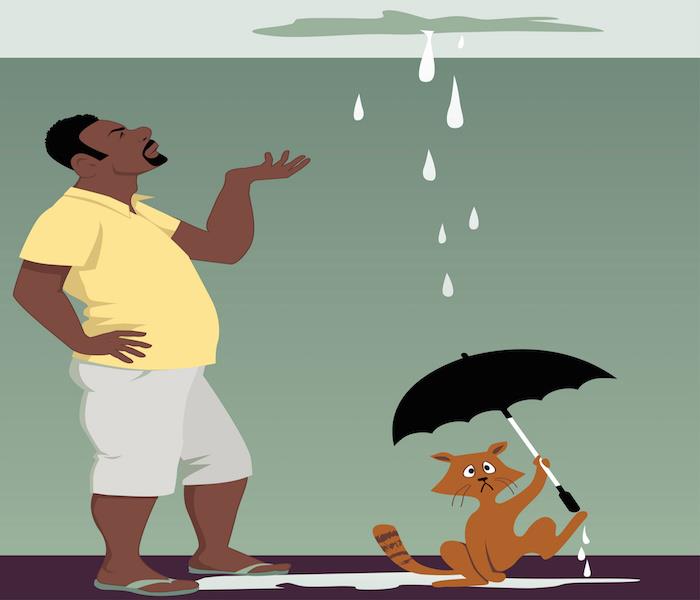Recent Water Damage Posts
The Nose Knows: Why Strange Odors Might Be Mold
4/18/2024 (Permalink)
Strange odors at home? Don't ignore them – they could signal mold. Here's why it matters:
1. Florida's Mold-Friendly Climate: High humidity in Florida creates ideal conditions for mold growth.
2. Health Risks: Mold exposure can lead to allergies and respiratory issues.
3. Property Damage: Mold can damage your home and belongings if left unchecked.
What to Do:
- Investigate any unusual smells or signs of water damage.
- Consult professionals like SERVPRO® for a thorough inspection.
- Address moisture issues promptly.
- Trust experts for safe mold remediation.
Stay vigilant and keep your home mold-free for a healthier living environment. Contact SERVPRO today for expert assistance.
6 Common Roof Leaks
7/5/2022 (Permalink)
When it comes to roof leaks, even the smallest of consistent drips can cause major water damage. This makes stopping any of these potential leaks of paramount importance. But in order to stop these leaks, you need to know where to look and what to look for. Here are the six most common spots where you may find leaks in your home.
Around the Chimney
While it may seem like your roof and chimney are one single entity, they’re actually not. They are connected using strips of flashing which covers the large gaps between the roof and chimney. This flashing often is a primary source of leaks in the home. Over time, this flashing might pull away from the brick or rust. It’s generally easy to spot this when it happens so if you have a leak and the flashing is pulled away from the brick, you’ll know where the leak is originating.
Shingles
The shingles on your roof serve many functions for your home. One way they protect your home is by ensuring the heat or cold doesn’t get into your home. Another way it protects your roof is by keeping water out which helps you avoid potentially dangerous water damage. However, as much as these shingles protect you, they can be damaged by old age or a big storm. If the shingles are damaged or missing, water may be able to seep into the underlayment and sheathing which can then cause leaks inside the home. To make sure you’re not in danger of these leaks and subsequent water damage, look for the signs of damaged shingles which include lost granules, curling or buckling shingles, or obvious missing spots.
Gutters
The gutters that stretch around your roof likely collect leaves, pine needles, and other debris as it falls from overhanging trees. This debris can clog or damage the gutters causing water to collect when it rains. The standing water can then back up in the gutters and cause leaks to occur. People failing to clean their gutters is one of the most common causes of water leaks. But there are other potential dangers. The water can freeze and that has the potential to cause many other problems. Even if you don’t expect that there are leaks, you should clean out your gutters regularly to ensure they don’t clog or become damaged.
Valleys
Unless you have a flat roof, there will probably be spots on your roof where two different planes will intersect. The line where these planes meet is commonly referred to as a valley. These valleys may be covered with flashing, rolled roofing, or some other material depending on where you live. These valleys can be potential dangers because water tends to collect in these low areas and any potential problems with its covering can allow water to seep into the house causing significant water damage.
Ice Dams
Ice dams are potential problems in cold climates in which snow that accumulates on a sloping roof melts and flows down the roof underneath the blanket of snow that insulates the roof. This causes a dam of ice to build up on the edge of the roof and catch melted snow rather than allowing it to run off as it should. This backup of water has the potential to cause major leaks in your roof and cause significant water damage in your home.
Roof Penetrations
Any objects that extend above the roof such as vents, pipes, or other penetrations have the potential to cause leaks in the roof. Most of these objects will have flashing around them to connect them to the roof so it’s important to check the flashing to ensure that there’s no rust or loose spots on or around it. As flashing is a primary source of leaks in homes, this has the potential to cause serious water damage to your home.
Leaks, even minuscule ones, have the ability to cause major water damage to your home. Most of these leaks originate from the roof and allows water to drip down into the attic or walls which can be difficult to see until it’s too late. That’s why it’s important for homeowners to be vigilant of any potential problems. If you suffer water damage in your home, call on the professionals at SERVPRO to remediate the problem.
Ways to Reduce Risk of Water Damage
6/29/2022 (Permalink)
Experiencing water damage can be a traumatic event for a homeowner and it could possibly destroy your possessions. Most water damage comes from problems with the house’s interior plumbing. But there are ways that you can help prevent these situations from occurring with just a little routine maintenance. These tasks will help to reduce the chances of suffering interior water damage.
Plumbing Supply System
The are several events that may happen that could indicate that your plumbing supply system may be failing. These include an increased monthly water bill, banging pipes, rust stains, moisture in the walls or floors, and signs that there’s wet soil erosion near the foundation. You can help to prevent a plumbing supply system failure by setting your thermostat to 60 degrees or higher during the cold winter months, let your faucets drip, or insulate your pipes which will help to reduce the possibility of your pipes freezing. Another way to help is to install a leak detection system.
Toilet
A toilet backing up and overflowing is a fear of every resident of a home. To make matters worse, the toilet overflowing can cause serious water damage to your home. However, there are ways that you can prevent a toilet from overflowing and damage from occurring. The easiest and most efficient way you can ensure an overflowing toilet doesn’t cause water damage is by waiting for the flushing valve to completely finish refilling the tank and the bowl after flushing the toilet. If it looks as though the toilet may overflow, you can turn off the supply valve before any overflowing occurs. You should also inspect the toilet’s components at least twice a year. This includes the fill valve, the supply valve, the flush valve, and the supply line. If all else fails, you may want to upgrade the supply line to a braided steel hose, a sturdier choice.
Water Heater
A slow leak, a sudden burst in the tank, and supply line failures are the most common problems for water heaters. To reduce the chances of water damage due to a water heater problem, you should replace your water heater after 10 years. You can find the manufacture date on the upper portion of the tank. Conducting maintenance on the water heater such as flushing sediments and inspecting the water heater’s anode rod are ways that you can increase the life expectancy of the heater. Make sure you also inspect the valves which will ensure that the tank is operating properly. If you’re able to, use ball valves rather than grate valves.
Plumbing Drain System
A study by the Insurance Institute for Business and Home Safety (IBHS) found that more than half of all plumbing system failures come about as a result of sewer backups. To prevent a sewer backup in your home and to reduce the chances of suffering water damage due to it, have a plumbing professional install a backflow prevention assembly into the home’s sewer system if it’s connected to the city’s sewer system. This is especially a problem for older homes and those located downhill or below street level. If you’re planning on planting trees, do so away from lateral drain lines to prevent the possibility of the roots from damaging the piping. And as always, never pour grease down the drain as this can cause a backup in the pipes.
Washing Machine
Washing machines use a lot of water. Older machines can use up to 40 gallons of water while newer machines use 27 gallons and energy efficient machines use 14 gallons. That’s a lot of water that can cause a great deal of damage if there’s a problem with your washing machine. Just one burst inlet hose has the ability to flood a laundry room in a matter of minutes. To make sure this doesn’t happen to your washing machine, you should replace the rubber hoses every three years. You may also want to upgrade the hoses to a sturdier braided steel. Make sure you turn off the hot and cold water supply valve when you plan on leaving the house for an extended period of time, don’t overload the machine, and only use the washing machine while someone is in the house. These will all reduce the potential risks of machine failure.
Water damage has the potential to cause tremendous havoc for a homeowner. It can put into question the structural integrity of the house and permanently damage personal possessions. These tips will help you to prevent water damage from occurring in your home. However, if you do suffer from water damage, contact SERVPRO immediately to come remediate the problem.
How You Can Stop Water Damage from Occurring
6/21/2022 (Permalink)
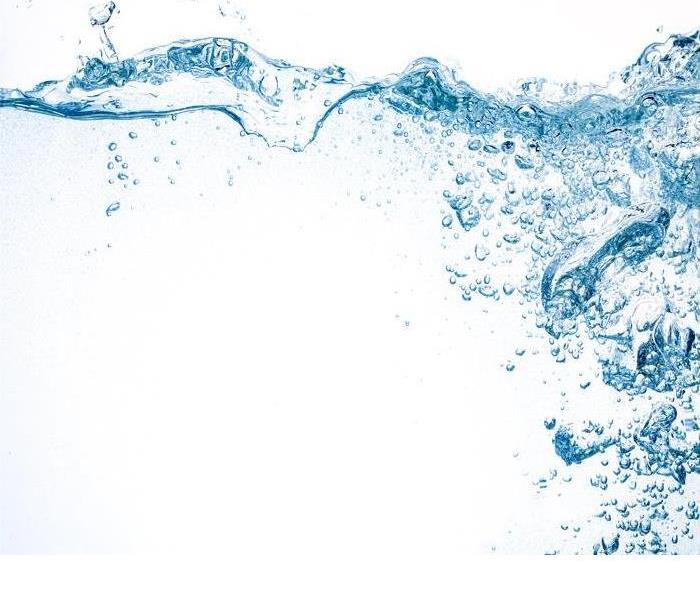 The damage that water can do is sometimes worse than a fire in older buildings.
The damage that water can do is sometimes worse than a fire in older buildings.
How You Can Stop Water Damage from Occurring
You want to avoid water damage in a building at all costs. The damage that water can do is sometimes worse than a fire in older buildings. You need to be vigilant about a few important areas of the building. You can take a few steps to stop water damage from ever occurring.
Watch For Problems with Flashing
The flashing on the roof of the building can rust, fall off or become dislodged at any time. You want to constantly watch for problems with the flashing especially after storms or high wind. If you notice exposed flashing, rusted pieces or gaps around corners on the roof, then you need a contractor to repair that flashing immediately since water will have an easy path into the building.
Keep Gutters and Downspouts Clear and Repaired
Gutters and downspouts do the important work of preventing water from drenching exterior walls and pooling at the base of the building. You would have to constantly deal foundation damage and disintegrating walls without them. Keep the gutters and downspouts clear. Clean them out regularly to prevent debris from building up. If anything comes loose, then secure the gutter or downspout back to the building. Replace corroded or damaged sections. Consider using a gutter guard to block debris and a heating system to prevent ice dams.
Have Your Roof Inspected Regularly
Your roof could have any number of problems that you would never see without specialized training and tools. Those hidden problems could be allowing huge amounts of water to pour into the walls and rot away the framework of the building. You need to have your roof inspected regularly by knowledgeable professionals. You want to do this in the spring and the fall to check for damage between seasons.
Pay Attention to Plumbing Fixtures
Pay close attention to the plumbing fixtures. This could be any sink, drain or toilet. If they start running slow, losing pressure or backing up, then you have a potential issue that could already be causing water damage to the building. You need to be observant and call for help as soon as you notice anything unusual.
Think About Putting Drains or Pans in Key Areas
Floor drains and collection pans can stop water damage from occurring. They need to be put in key locations. Drains can go in bathrooms or basements. Collection pans can be set under hoses, appliances or even frequently used sinks.
Carefully Examine Your Plumbing Twice a Year
You want to walk through the building and examine the plumbing at least once every six months. Look for any signs that something is leaking such as mold, discolored floors or moisture on the fittings. Check the condition of the pipes. Have anything that is leaking, damaged or suspicious inspected and replaced by a plumber.
Have Your Sewer Lines Professionally Inspected
Schedule regular sewer line and backflow system inspections once every year or two. If the sewer line or backflow preventer breaks, then the building or foundation could be quickly flooded with wastewater. An inspection will ensure that everything is in good condition and working properly.
Have Primary and Backup Sump Pumps
If there is a basement, put primary and backup sump pumps in the building. The main pump will turn on once water causes a float to rise on the unit. The pump will remove water. The backup pump will activate if the first one fails or water is coming in too fast for one unit to handle.
Keep a Leak Repair or Management Kit Ready
Create a leak repair or management kit that includes things such as duct tape, a wrench, sheets of plastic and sponges. Keep mops near the kit and make sure everyone knows where it is. If someone can get to the kit quickly when a leak is detected, then it might be possible to prevent water damage until SERVPRO arrive.
Installed a Monitored Leak Detector
Put monitored leak detection systems in the building. These systems will alert you if water starts leaking or filling a room. If the system is monitored, then a live person can react to the alert by contacting you, the authorities or a service technician. Some systems will even shut off the water if a leak starts.
Our Water Damage Restoration Process
Every water damage situation is a little different, and requires a unique solution, but the general process stays the same. The steps listed below illustrate our process for the “typical” water damage emergency.
Step 1: Emergency Contact
Step 2: Inspection and Damage Assessment
Step 3: Water Removal/Water Extraction
Step 4: Drying and Dehumidification
Step 5: Cleaning and Repair
Step 6: Restoration
Water Damage Restoration Equipment for Melbourne
4/25/2022 (Permalink)
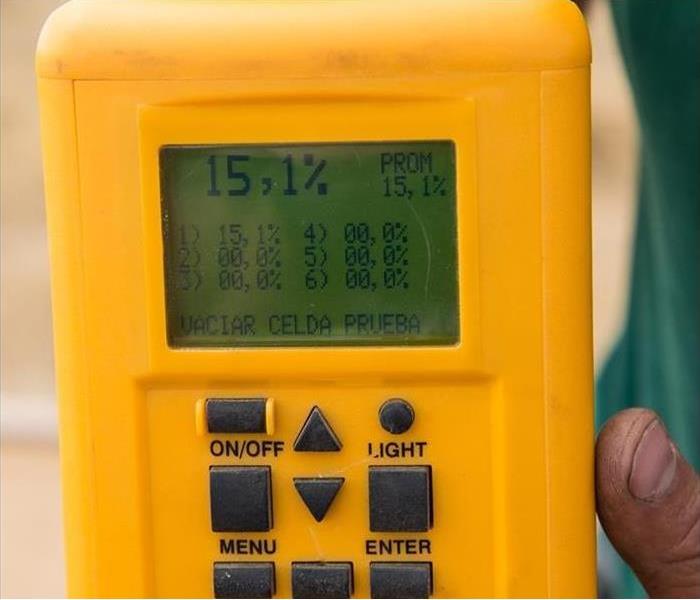 A SERVPRO Hygrometer--One of Many Tools for Water Damage Restoration.
A SERVPRO Hygrometer--One of Many Tools for Water Damage Restoration.
A Melbourne Water Damaged Property is Treated By an Array of SERVPRO Equipment
The world of Melbourne water damage restoration is one of intricacy and precision. For restoration strategies to be a success, they need to be backed up by the right equipment and skills. This can mean something as sturdy as a pair of safety boots or an industry specific tool like a moisture meter.
The assortment of tools put together for every job reflects the uniqueness of water damage restoration. As every task is different, so too is the toolkit. While not all water damage requires technicians to rely on heavy duty equipment, there are some occasions when demolition tools are needed to remove compromised materials as fast and as safe as possible.
Protective Clothing
Whether the level of risk posed by contaminants is high or negligible, technicians are required to wear protective clothing. This gear includes rubber gloves, rubber boots, safety goggles, and a breathing device to filter potentially harmful gases and particulates. Hazmat suits are required under extreme clean up conditions such as crime scenes, severe sewage backups, asbestos, and lead remediations. In areas where moisture has been present, mold, mildew, and bacteria must be taken into account.
Moisture Reading Devices
The moisture meter (or moisture detector) is one of the most important tools for a water damage restoration specialist. This device is utilized to measure the moisture percentage of materials so that technicians know which areas are the most badly affected and need attention most urgently. It is not possible to make these kinds of assessments by sight alone, so a moisture reader is an essential part of the restoration toolkit. Hygrometers detect the relative humidity (RH) in an open environment to ascertain the level of humidity in the ambient air.
Clean Up Tools
If it is clear that the affected part of the property is partially or entirely lost to water damage, a range of demolition tools may be used to remove the most badly destroyed materials. A sledgehammer and an axe, though not hi-tech tools, can be useful to knock down internal components, and a pressure washer brought in to channel out the water.
Drying and Displacement Tools
Once most of the standing water has been extracted from the property employing industrial grade water pumps (truck-mounted and portable), wet vacuums and sump pumps, more precise drying techniques can begin. There are some various tools which can be used to help with this. Industrial sized high-velocity fans, air movers, dehumidifiers (refrigerant and desiccant for large jobs), and heaters are often employed after standing water has been dealt with, and only small amounts of liquids and moisture remain.
SERVPRO technicians can put the finishing touches on the water damage in a Melbourne property by using special fogging machines that disperse antifungal and antimicrobial products to sanitize and remove lingering odors. The well-equipped vehicles of SERVPRO also carry air scrubbers, ozone machines, and yes, even mops, squeegees, and buckets. Call on us to restore your property to its pre-water damaged condition "Like it never even happened."
We Use Advanced Drying Equipment and Techniques
Our advanced equipment helps to detect hidden moisture, extract the standing water quickly, and thoroughly clean and dry your home in Melbourne, Palm Bay and Sebastian. SERVPRO of South Brevard will finish the job with professional deodorization and sanitizing agents for your comfort and safety. Call us 24/7 for an immediate emergency response. (321) 777-5131
How to Start the Water Damage Restoration Process Before Professionals Arrive
1/17/2022 (Permalink)
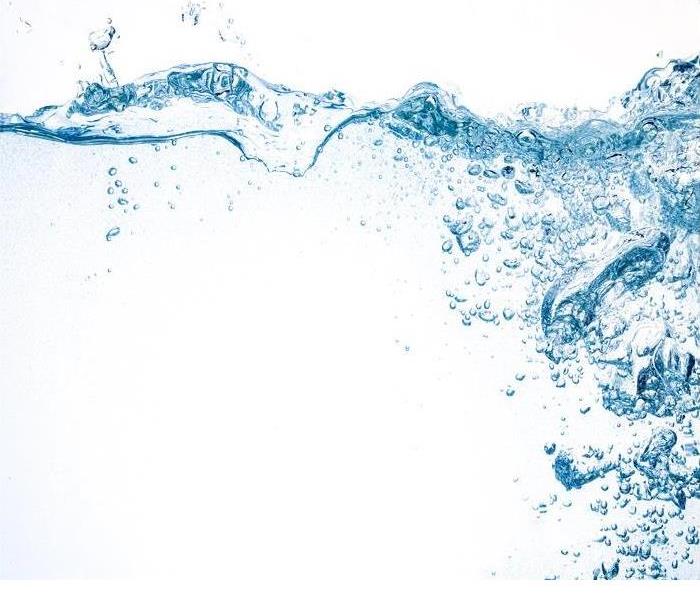 Water can sometimes do more damage than fire in older homes/buildings.
Water can sometimes do more damage than fire in older homes/buildings.
If you have water damage in your home, it’s important that you hire professionals that are certified by the Institute of Inspection Cleaning and Restoration Certification (IICRC) to handle the cleanup job. These technicians have been trained to handle the cleanup and restoration process so that the damage caused is kept to a minimum. However, before the professionals arrive, there are some things that you can do to begin the process.
No matter how minimal the damage seems to your home following water damage, it’s important to bring in certified professionals to get rid of any serious health or structural threats. Storm surges and floods can bring in contaminated water that can carry pathogens and become a breeding ground for mold. If the existence of these contaminated waters or mold in the home are not quickly addressed, the mold spores can spread throughout the building and could become even more difficult to remove. If the microbial in the building is too great, governmental agencies have the option to condemn the structure.
Why Homes Are Sensitive to Water Damage
When the water that’s collected in your home recedes, the moisture from the damage is difficult to detect. This is the main reason why homes are sensitive to water damage. Microbial growth can begin within 24 hours of the damage due to standing water and can saturate different types of textiles and can seep through your drywall. The moisture has the ability to collect behind walls and create troublesome mold and bacteria out of the sight of occupants. If you react quickly, you may be able to save items such as clothes and furniture. But make sure to be very careful when entering a building that has recently been flooded. Any exposure to wildlife and contaminated water that may have accompanied the flooding could result in serious injury.
Shut Off Electrical Power
When entering your home after water damage, it’s important that all electrical power has been shut off. Any exposed wires or electrical devices that remain plugged in have the potential to electrocute people and could result in major injury or death. When re-entering the home for the first time, it’s best to do so slowly as snakes, reptiles, and rodents may be hiding under any debris and could jump out and bite an unexpecting occupant. To protect yourself against any hidden wildlife and any airborne contaminants, you should wear protective clothing from head to foot. Some of the necessary clothing when re-entering the home includes vapor respirator, rubber gloves, and eye protection. Also make sure to wear thick boots that can withstand potential puncturing and animal bites.
Identifying Which Items Are Compromised By Water Damage
Certified professionals have the training to be able to quickly identify which items have been compromised by the water damage. Typically, anything porous materials might need to be discarded if the materials have come into contact with contaminated water. Some of these items include mattresses, box springs, pillows, and particle boards. These items trap more moisture than other items and foster the growth of microbes. To get the process started before the technicians arrive, you can get rid of these items. When discarding of items, make sure to record and itemize the items for insurance purposes.
Identifying and Removing Excess Moisture
When the professionally certified technicians arrive, they’ll be able to track down and remove any excess moisture. They’ll locate the moisture pockets using equipment that measures the amount of moisture in hidden pockets as well as behind tile or any other materials that may not seem wet from the outside. Once the pockets of moisture are found, the technicians expose them to air by removing any drywall or other materials that might be in the way.
With the location of the moisture discovered, the professionals will then begin the cleanup process which could include pressure washing with powerful detergents. They also have the ability to speed up the drying process preventing any further mold growth or other harmful bacteria. If they locate mold or bacteria colonies, they have the training to be able to remove the threat using chemical or mechanical methods.
If you have water damage in your home, it’s important that you hire the IICRC certified professionals at SERVPRO to handle the cleanup and restoration. Doing so will help you avoid further damage and potential health effects.
Water Damage Factoids in Satellite Beach
12/15/2021 (Permalink)
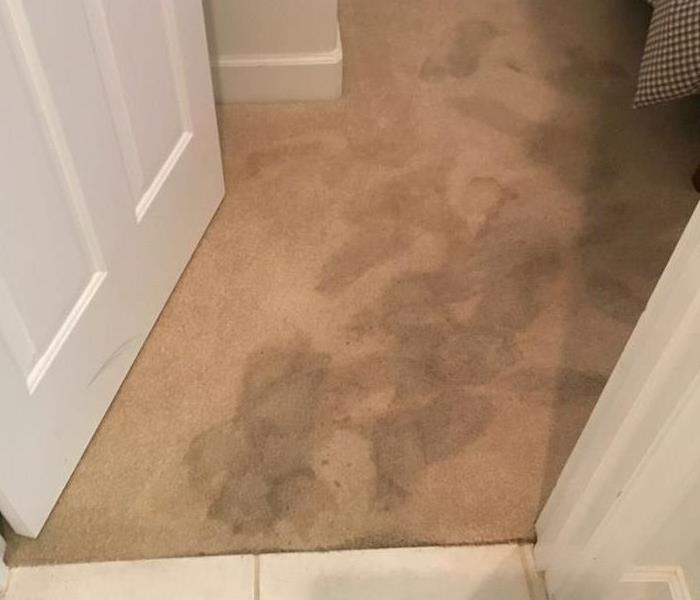 Be prepared on the Florida coast for water damage and call us if disaster strikes.
Be prepared on the Florida coast for water damage and call us if disaster strikes.
SERVPRO's Water Damage Restoration Service for Your Satellite Beach Property
No one wants to experience a flood or rapid amount of unwanted water cascading into their home in Satellite Beach resulting in water damage to furnishings, flooring, and building materials. Whether the water intrusion results from Mother Nature (hurricane) or a leaky faucet, the water damage can be profound and unsettling. Nevertheless, individuals who respond to the water damage immediately by calling SERVPRO of South Brevard, effectively can limit damages, reduce repair costs, and breathe a bit easier. Learn more about water damage and why it is expedient and effective to hire a restoration service by reviewing this short guide:
Water Damage
Can arise as the result of household or construction issues with the property. Here are some examples.
• Poor ventilation: over heated attic air or poor air circulation in the attic or crawl space resulting in moisture and condensation.
• Leaking pipes: older homes have problems with copper fittings or poor installation of PVC plumbing.
• Exterior damage to siding or trim caused by improperly placed sprinkler heads.
• Slab foundations: large settlement cracks allow water wicking into carpeting, or laminated or pine flooring, baseboards and walls.
• Roof leakages: poor shingle or roof tile installation, old and time to replace.
Water Damage And Mold Growth
It's important to note that excessive water on your property in south Florida results in high levels of ambient air moisture unless corrected by mechanical means. Run A/C and small dehumidifiers to maintain an interior moisture level of about 45%. Fungi thrive in the moist, wet environment created by standing water. The mold spores can rapidly develop into colonies of mold which may emit mycotoxins.
How To Handle Water Damage. Very Simply?
Call SERVPRO of South Brevard, a premier water damage restoration franchise that is always close-by. In some cases, homeowners seek to clean up the water damages on their own. Mopping up some pooling water from a small leak is fine. But, if damage has ensued to furniture, flooring, or walls, it is time for corrective measures by trained professionals. The HVAC, wall voids, attics, and crawl spaces must all be inspected for hidden pockets of water and moisture. Why expose yourself to health and safety risks? OSHA approved clothing, goggles, and safety gear are standard fare for this line of remediation. There are a wide range of health and safety risks that you could expose yourself to if you seek to complete the restoration process without professional help. Our water damage experts possess the extensive training, experience, equipment and cleaning products necessary to remove the standing water quickly and correctly, along with mold and musty odors.
Call the professionals of SERVPRO South Brevard today to fix the water damage to your Satellite Beach property. Our goal is to make your home safe again from damage and possible mold infestations. With you in mind, we work politely and professionally to keep you safe while saving you money.
Locally Owned and Operated
We live and work in Satellite Beach too; we might even be neighbors. As a locally owned and operated business, SERVPRO of South Brevard is close by in Port Malabar and Palm Bay and ready to respond to your water or flood damage emergency. Call us 24/7 for assistance. (321) 777-5131
Protecting Wood from Water Damage
6/28/2021 (Permalink)
Most houses have wood integrated into their structures in some way or another. Often these wooden parts of the house are used for decks, doors, or garage doors. The problem with wood that is open to the elements is that water damage is always a possibility. Similar to issues with the foundation, if gutters are absent from the building or are defective so that water flows straight down rather than being directed away from the building, the result could be rotting, mold growth, or other problems associated with wood being affected by water.
Keep Outside of the House Clean
When rainwater flows off the roof, it brings with it the mud, sand, and other debris that may have collected on the roof. What fell from the sky as clean water is now dirty water that can leave a trail on the house. The result of this could be the staining of doors, windows, and siding which could negatively affect the look of the house and force you to clean the house more frequently. The primary purpose of gutters is to direct water away from the house so that the water doesn’t flow straight down where it can cause trouble.
By doing this, the water that would have caused these unsightly features will now be directed well away from the house leaving the home with a cleaner outside look.
Keeping your Business Safe from Water Damage
6/12/2021 (Permalink)
As a business leader, you’ve got enough to worry about with your day-to-day operations that you don’t want to think about problems with your facility. However, it’s not uncommon for Viera, FL, companies to contend with leaking pipes or other matters that can lead to flooding and water damage. It’s important to identify the causes of these potential disasters and troubling incidents so you can prevent them and more effectively clean them up.
Potential Hazards
In some cases, something such as a toilet backup or a slow leak in a pipe will only cause minor concerns in a bathroom or break room. However, if these things go undetected, you could face significant financial consequences or even potential interruptions to your business.
Flooding could damage or ruin the carpet, drywall, ceiling tile, furniture or electronics.
Water damage could create an unsafe environment for employees.
Water damage may not be covered by your insurance.
The Gradual Issues
Leaking pipes could drip water onto floors or into the walls of your office over a long period of time without you even realizing it. Over the course of months or even years, this can rot away the drywall or subfloor. This problem could even encourage the growth of mold or other fungal development.
A Sudden Rush
If your building is aging, you may need to take a look at the plumbing system and make sure the pipes are still in good shape. A pipe break could expel large amounts of water into your facility, which could result in significant flooding. Even if you react quickly to this incident, you could still face heavy costs and loss of equipment and supplies.
Mother Nature
A weak roof or poor foundation could be vulnerable if heavy rain hit during a thunderstorm. Leaking pipes will put water on your floor slowly, but severe weather could inundate you with too much to handle.
If any of these events occur in your building, you know where to turn. Contact a commercial water damage specialist immediately.
Does a flood mean new carpet?
4/16/2021 (Permalink)
Can my carpet be saved after water damage?
When you have a pipe break and an unexpected flood in your home, one of the biggest concerns is the damage to your floors, walls, and possessions. It behooves you to save as much as you can. It's not just economically sound, but environmentally smart, too. When your carpet gets soaked, can it be saved? The good news is that it often can be cleaned and kept. Consider the following factors:
What is the source of the flooding water?
If the water is non-contaminated or is grey water, the rug can be cleaned and used again.
Grey water includes water from washing machines, dishwashers, bathtub or shower overflow, and toilet water with urine only.
How long has the flooring been wet?
Clean water becomes grey water after 24-48 hours, and grey water becomes black water after 24-48 hours. Black water is a source of fungus, bacteria, and other pathogens. Flooring saturated with black water must be replaced.
Does the water have minimal contaminants?
Water from a pipe break, hot water heater failure, or overflow from bathroom, kitchen, and utility sinks is considered clean water. Carpets soaked with this type of water can be cleaned and dried. The pads can also undergo a full restoration.
In instances where the water is grey, approaching black, it is advisable to clean the rug but replace the pad.
Be Aware of These Contaminants
There are some contaminants that are too toxic to mess around with. If your flooring is exposed to the following, you will need a full replacement:
Water from sewage or storm drain backup
Water with fecal matter, vomit, or other biological contaminants
Water with heavy metals or chemicals
If you have a pipe break with significant flooding, let the professionals in Melbourne, FL asses your flooring damage. A restoration and cleanup crew will make your home look "Like it never even happened."
Water Damage and Homeowners Insurance
3/22/2021 (Permalink)
Does Homeowners Insurance Cover Water Damage?
Homeowner's insurance is useful in times of an emergency. Insurance allows you to avoid having to pay out-of-pocket for expenses that are related to damage to your home. Submitting a claim after your home is damaged by water helps you recover money spent on repairs. However, it is important to know that there are positive and negative points to filing a water damage insurance claim has its good points and bad points.
Water Damage Coverage
Your insurance company covers certain types of water damage. In most instances, the insurance company will cover any damage that is the result of a sudden event. For example, if the broken dishwasher leaks water and causes any water damage, you are covered by your policy. But, any damage that results from a dishwasher that malfunctions because of inadequate maintenance or neglect will not get covered.
No Coverage
An issue that homeowners face that is not covered by a regular homeowner’s insurance policy is flood damage. If a local river overflows and floods your home, the flooding is not covered by your homeowner’s insurance policy. You will need to purchase a separate insurance policy to cover flooding. This type of insurance is advised for anyone living in an area prone to flooding.
Water damage is covered through homeowner’s insurance
Unfortunately, there are some limitations to this coverage. An accident that occurs suddenly will likely get covered. However, flood damage that arises from poor maintenance may not covered by your policy. It is important to know that you may find yourself disagreeing with your insurance company about the nature of your water damage. An incident that you believe is the result of a sudden accident may not get viewed as such by your insurer. Your insurance company may argue that the damage was caused by improper maintenance of your home.
If you need help with flood damage in Melbourne Beach, FL call our teams of professionals at (321) 777-5131
#waterdamage #homeownerinsuranceandwaterdamage #Melbourne #SERVPROSouthBrevard
House Flooding
11/3/2020 (Permalink)
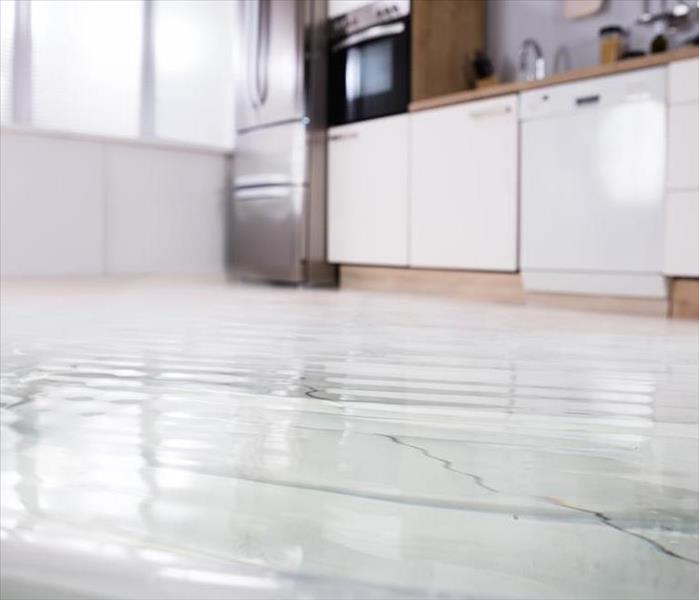 Flooding on the kitchen floor due to broken pipe.
Flooding on the kitchen floor due to broken pipe.
Water flooding in your house, business, or place of work can happen at any time. Most of the reasons for flooding are due to pipes breaking, backed up septic tanks, and/or water heaters. When those times happen we dry up the areas and think everything is dry and fine. But what most people do not realize is that moisture can be behind walls, cabinets, and rugs.
Here are some facts:
- Mildew (mold in early stage) and molds grow on wood products, ceiling tiles, cardboard, wallpaper, carpets, drywall, fabric, plants, foods, insulation, decaying leaves, and other organic materials. Mold growths, or colonies, can start to grow on a damp surface within 24 to 48 hours.
- It is not visible right after it happens meaning if you do not get a rapid response on the matter it will grow.
- Even if you dry the area it can be wet behind walls
- Bleach does not stop the growth behind the walls.
What To Do After Flooding
- Turn off Electric to the affected area
- Call SERVPRO of West Brevard
- Remove excess water by mopping and blotting.
- Wipe excess water from wood furniture after the removal of lamps and tabletop items.
- Remove and prop wet upholstery and cushions.
- Place aluminum foil or wood blocks between furniture legs and wet carpeting.
- Turn air conditioning on for maximum drying in summer.
- Remove colored rugs from wet carpeting.
- Remove art objects to a safe, dry place.
- Gather loose items from floors.
What NOT To Do After Flooding
- Don't leave wet fabrics in place. Hang furs and leather goods.
- Don't leave books, magazines, or other colored items on wet carpet or floors.
- Don't use your household vacuum to remove water.
- Don't use television or other household appliances.
- Don't turn on ceiling fixtures if the ceiling is wet, and keep out of rooms where ceilings are sagging.
#waterfloodinginhouse #waterdamage #SERVPROofsouthbrevard
Flooding and Why Time is important.
10/12/2020 (Permalink)
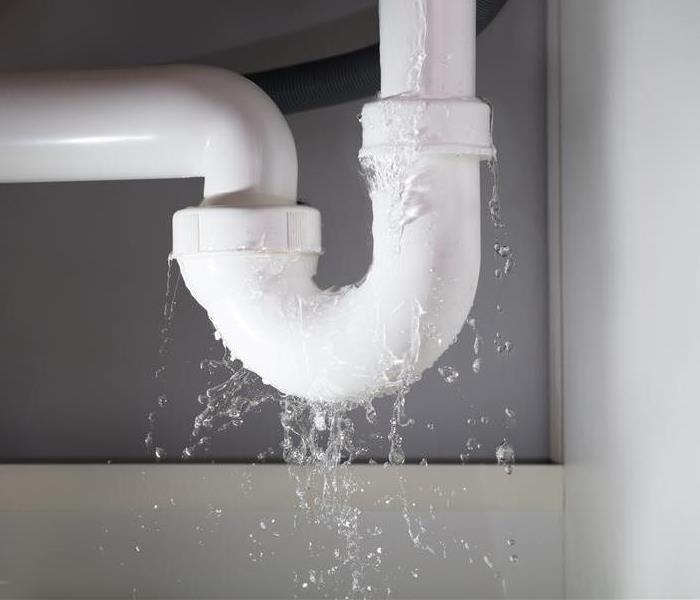 Pipe leaking with overflowing water
Pipe leaking with overflowing water
Many of us have experienced a leaky pipe, storm damage, backed up toilet, overflowed tub, and even septic back up. When a flood happened we rush to dry up the floor and clean the area. But what most do know is the moisture can cause mold to start growing. Did you know that mildew and mold will develop within 24-48 hours of water exposure?
Here are some important tips when floods happen.
- Take photos of the flooded area from the outside area
- Shut off electric to the area flooded ( do not enter a flooded room with electric on )
- Try to dry most of it if possible
- CALL our offices at 321-777-5131
SERVPRO of South Brevard will make it feel
"Like it never even happened."
Bathroom Supply Lines
6/23/2020 (Permalink)
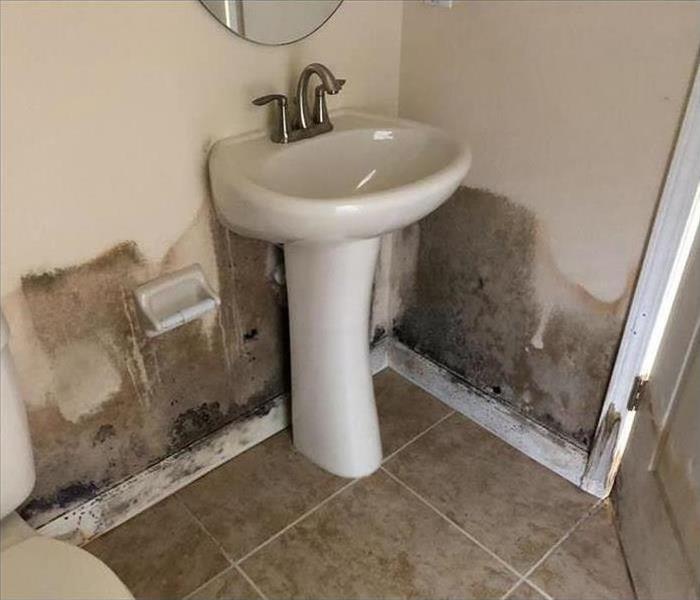 Supply line damage may lead to some pretty serious problems, such as standing water or mold growth
Supply line damage may lead to some pretty serious problems, such as standing water or mold growth
When is It the Time to Replace a Supply Line in Your Bathroom?
Many of your household appliances that use water require a supply line. Because they are so commonly used, supply line damage can cause some major issues. It is important to call a professional as soon as you notice an issue. This can help prevent water build up in your home in Melbourne Beach, FL. Changing these lines when needed may actually help you avoid problems later on. How do you know when it's time to replace it though?
Check the Warranty
You may find that many of these hoses come with a warranty. It really just depends on what type you have. Most plastic lines come with a 5-8 year warranty. This means that you are responsible for replacing it if anything happens to it after that time is up. Steel braided ones often have a lifetime guarantee. While they are generally more expensive than the plastic ones, the benefits may be worth the extra cost. Always ask the seller about the warranty before you decide to purchase.
Watch for Damage
Supply line damage may lead to some pretty serious problems, such as standing water or mold growth. This is why it is a good idea to have a professional come out if you notice a supply line leak. Always shut off the water if you see an issue. This could be anything from a small bathroom leak to pretty serious flooding. Turning off the water can help prevent further damage from happening in your home.
If you are still unsure whether you have supply line damage, it is best to call a professional restoration company to come take a look. They may be able to help you resolve a number of issues that arise in this type of situation, such as fixing the leak and cleaning up the water. If your line gets replaced, always ask what type of warranty you are getting so that you will be aware if any future problems occur.
The 3 Best Methods To Identify a Leaky Toilet
6/9/2020 (Permalink)
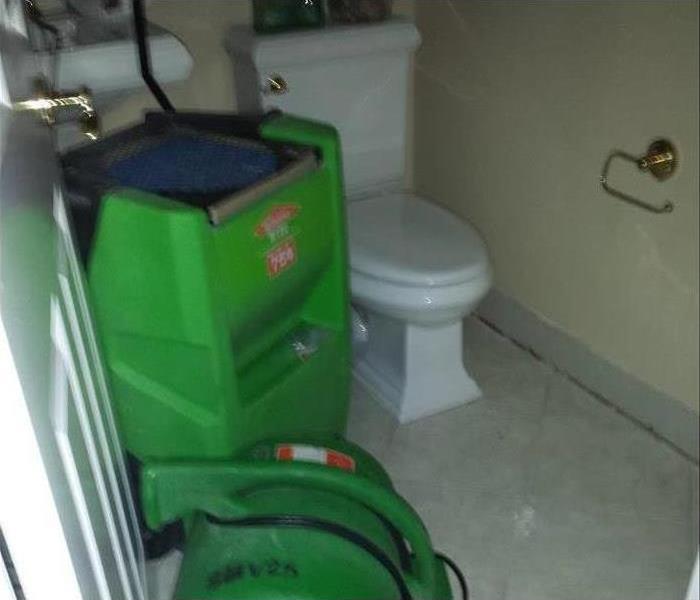 Air movers in a water damage Melbourne, FL bathroom
Air movers in a water damage Melbourne, FL bathroom
How To Detect A Toilet Leak
While some problem areas around your Melbourne, FL, home often make themselves known in a very obvious way, some can go silently undetected for long periods of time. One of these problems can come in the form of a leaking toilet, which can cause both water leaks on your bathroom floor and an expensive utility bill, to boot. If you think your home may be experiencing a leaky toilet, here are the three best methods for detecting a problem and solving it before the consequences become any worse.
- Test the toilet water tank using food coloring. While it might seem strange, using food dye as a method for seeking out leaks is quite effective. Start with the toilet you’re concerned about and flush it normally. Wait through its entire cycle, then add 4-5 drops of red or blue food coloring to the tank’s water and wait 20-30 minutes. Once the time has passed, return to the toilet and check the bowl for changes in color. If the water is clear, there’s no sign of a leak. However, if the water is slightly discolored by the dye, you’ve found your leaking toilet.
- Check for problems with the float. While there’s an overflow pipe installed in every toilet tank to prevent just that situation, there can sometimes be overflow anyway due to a faulty float. Since the float is supposed to tell the inlet valve when to shut off the water, any extra water can indicate a possible leak, meaning you might need a new float.
- Consider that the wax ring might be dry or installed incorrectly. Wax rings on toilets dry out all the time, making them an easy suspect when you come across a bathroom leak. Inspect yours thoroughly to see if this is the source of your water issue.
If you find yourself needing more assistance with identifying a leaking toilet in your Melbourne, FL, home, contacting professional water restoration experts who are here to help is the easiest way to ensure your water problem is solved.
Water Problems You May Find in Your Office Building
4/16/2020 (Permalink)
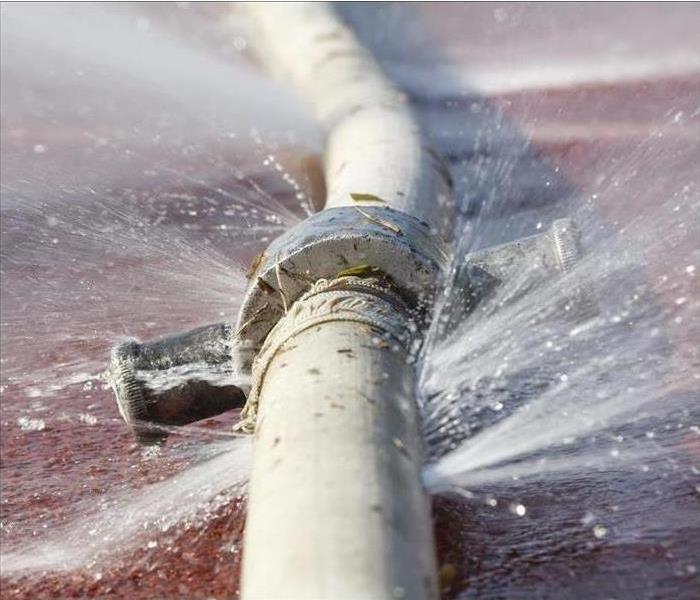 A pipe break could expel large amounts of water into your facility which could result in significant flooding
A pipe break could expel large amounts of water into your facility which could result in significant flooding
As a business leader, you’ve got enough to worry about with your day-to-day operations that you don’t want to think about problems with your facility. However, it’s not uncommon for Sebastian, FL, companies to contend with leaking pipes or other matters that can lead to flooding and water damage. It’s important to identify the causes of these potential disasters and troubling incidents so you can prevent them and more effectively clean them up.
Potential Hazards
In some cases, something such as a toilet backup or a slow leak in a pipe will only cause minor concerns in a bathroom or break room. However, if these things go undetected, you could face significant financial consequences or even potential interruptions to your business.
- Flooding could damage or ruin the carpet, drywall, ceiling tile, furniture or electronics.
- Water damage could create an unsafe environment for employees.
- Water damage may not be covered by your insurance.
The Gradual Issues
Leaking pipes could drip water onto floors or into the walls of your office over a long period of time without you even realizing it. Over the course of months or even years, this can rot away the drywall or subfloor. This problem could even encourage the growth of mold or other fungal development.
A Sudden Rush
If your building is aging, you may need to take a look at the plumbing system and make sure the pipes are still in good shape. A pipe break could expel large amounts of water into your facility, which could result in significant flooding. Even if you react quickly to this incident, you could still face heavy costs and loss of equipment and supplies.
Mother Nature
A weak roof or poor foundation could be vulnerable if heavy rain hit during a thunderstorm. Leaking pipes will put water on your floor slowly, but severe weather could inundate you with too much to handle.
If any of these events occur in your building, you know where to turn. Contact a commercial water damage specialist immediately.
4 Basic Steps For Replacing a Leaky Toilet
3/23/2020 (Permalink)
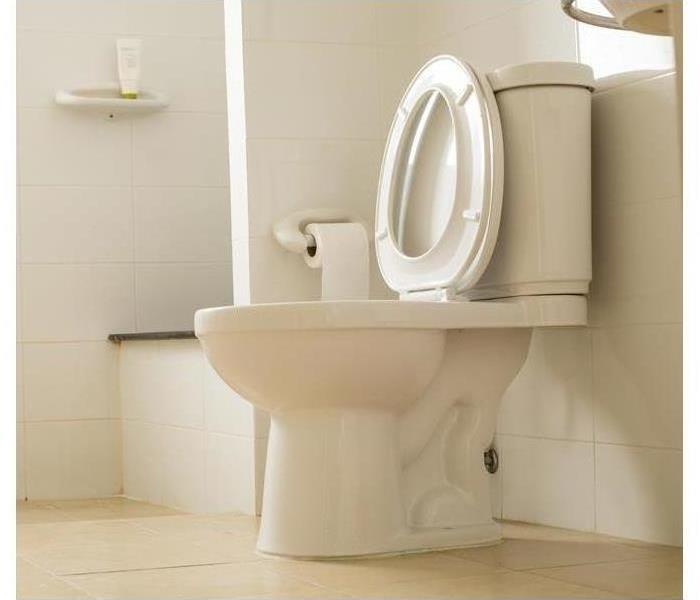 Replacing a leaky toilet in Port Malabar, FL
Replacing a leaky toilet in Port Malabar, FL
Replacing a Leaky Toilet
Your toilet was built to last a long time, but it cannot last forever. Over time, the fixture may begin to work less efficiently and can break or develop cracks. If you have decided that it is time to replace the leaking toilet in your Port Malabar, FL home, here are some basic steps to help you get the job done.
- Disconnect the Supply Line
Before you begin any work on the toilet, you need to make sure that it is no longer connected to the water supply line. Drain as much water from the toilet as you can and dry the rest with a sponge or towel. This will prevent any messes during the removal.
- Remove the Old Toilet
Once the leaking toilet has been dried, you can begin the process of removing it. You should unscrew any bolts that are securing it to the floor and then move the fixture back and forth gently to break the wax seal before moving the commode to another area.
- Prepare the Area
After the old toilet has been removed, you will need to clean up the area before you can install the new one. You should scrape off any wax that remains on the gasket and check that nothing has been damaged during the process. If everything looks fine, then you can proceed to the next step.
- Install the Toilet
If the leaking toilet has been removed successfully and there are no damages to the area that need to be repaired, you can begin the installation. Make sure that the toilet is placed correctly and is parallel to the wall behind it before securely tightening the bolts. Depending on your building code, you may need to seal the base with caulk.
If you don’t feel confident replacing your toilet on your own, or if there is already damage in your bathroom, a water damage repair service might be able to help. They can make any necessary repairs and ensure that everything is installed correctly to prevent the need for future toilet overhauls.
Protect Wood from Water Damage
2/18/2020 (Permalink)
Most houses have wood integrated into their structures in some way or another. Often these wooden parts of the house are used for decks, doors, or garage doors. The problem with wood that is open to the elements is that water damage is always a possibility. Similar to issues with the foundation, if gutters are absent from the building or are defective so that water flows straight down rather than being directed away from the building, the result could be rotting, mold growth, or other problems associated with wood being affected by water.
Keep Outside of the House Clean
When rainwater flows off the roof, it brings with it the mud, sand, and other debris that may have collected on the roof. What fell from the sky as clean water is now dirty water that can leave a trail on the house. The result of this could be the staining of doors, windows, and siding which could negatively affect the look of the house and force you to clean the house more frequently. The primary purpose of gutters is to direct water away from the house so that the water doesn’t flow straight down where it can cause trouble.
By doing this, the water that would’ve caused these unsightly features will now be directed well away from the house leaving the home with a cleaner outside look.
4 Steps To Take After a Water Heater Leak
12/31/2019 (Permalink)
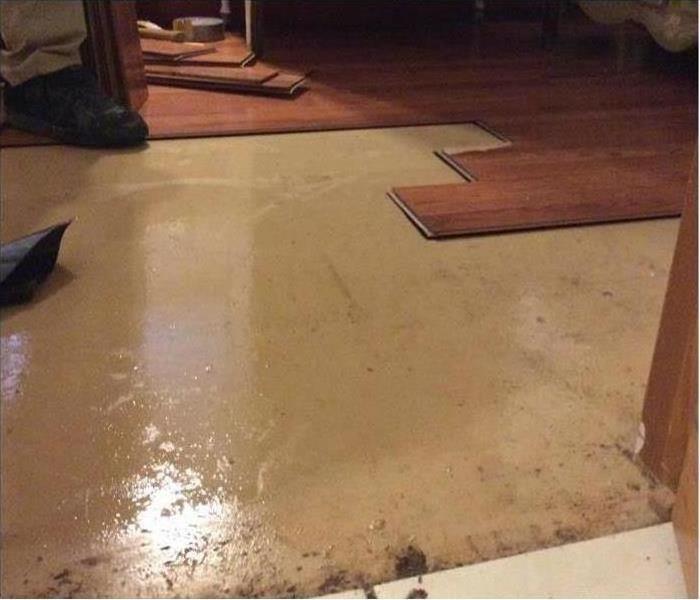 Water damage caused by a defective hot water heater leaking in Melbourne,FL
Water damage caused by a defective hot water heater leaking in Melbourne,FL
Cleanup Process: 4 Basic Steps
A leaking water heater can cause a lot of damage in a hurry. As soon as you notice that your failed water heater is leaking water into your home, you must call the plumber to fix it, but you also need to call water restoration specialists to clean up the mess it leaves behind. There are four basic steps to the cleanup process to ensure that no one is injured and that secondary damage does not occur.
- Safety Precautions
Water and electricity don’t mix, so the first thing you need to do is to make sure that you either unplug all appliances in the affected area or elevate the ones you cannot unplug. To do this, make sure you are wearing the appropriate protective gear, such as rubber boots. Never enter standing water without protection.
- Water Removal
A broken water heater in your home in Melbourne, FL, can expel a significant amount of water. Technicians will likely start by siphoning out the water before they can deal with the damage underneath.
- Item Removal
Everything the leaking water heater affects must be removed from the area. Rugs, furniture, toys, clothing and other belongings must be taken out. The experts then determine whether the items can be salvaged or not.
- Dehumidification
Even after the water is gone, the humidity levels in the room are likely higher than they should be. Technicians can use industrial dehumidifiers, fans and other methods to bring the moisture in the air down to an acceptable level so that mold doesn’t start to grow.
If a leaking water heater in your home causes more than a tiny spill, your best bet for getting the damaged repaired is a team of certified restoration experts. They can assess the problem and implement the appropriate solutions so that your home can return to normal as soon as possible.
3 Steps for Responding to a Broken Water Heater
10/16/2019 (Permalink)
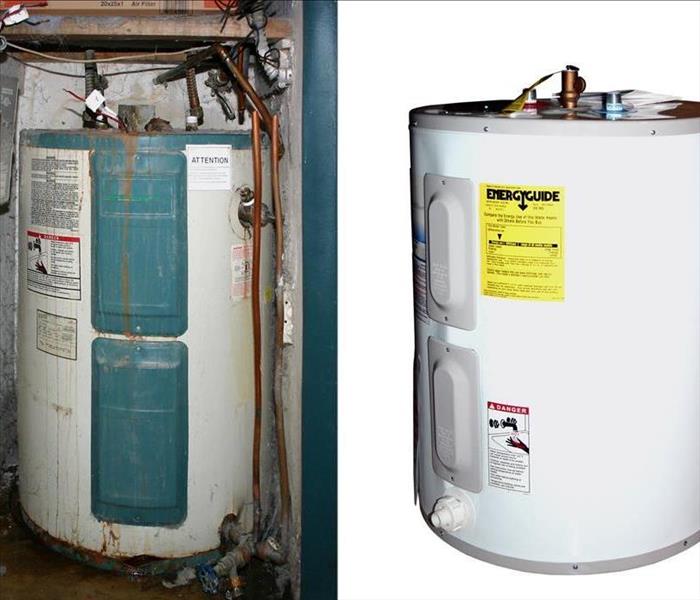 A broken water heater in Sebastian, FL
A broken water heater in Sebastian, FL
A leaking water heater may be one of the most inconvenient causes of water damage in your Sebastian, FL, home. After all, you use hot water from the moment you wake up until you wash the final dinner dish at night. A failed or broken water heater can disrupt your entire schedule, even without the resulting flooding.
Gallons of Water
Unfortunately, a broken water heater generally does lead to flooding. When those gallons of water rush into your home, whether it's in a basement or the main level of the home, there's going to be a bit of damage:
- Waterlogged belongings
- Weakened building materials
- Mold growth
- Unpleasant odors
- Spotting and stains
- Early deterioration of materials
The good news is that there are steps you can take to minimize these damages.
One: Act Quickly
It doesn't take long for the water from the leaking water heater to spread and soak into the surrounding area. The sooner you can shut off the water, stop the flooding, and dry out the room, the better. When the water is gone, you can recognize potential hazards and obstacles to recovering.
Two: Contact Professionals
Some types of water damage are covered by home insurance policies and others aren't. It's best to talk to your insurance agent to know whether the damages to your home will be covered by your policy. You should also contact a professional water remediation agency to remove large amounts of water or contaminated water, determine the extent of the damage, provide thorough drying services, prevent mold growth, and sanitize the area.
Three: Repair and Reconstruct
A failed water heater sends many gallons of water into the surrounding area in a short space of time. Sadly, it takes much longer to remove the water, so it isn't unusual for homeowners to face reconstruction steps. Carpeting, drywall, window treatments, and even the surrounding plumbing and electrical work may need to be replaced.
How To Handle Water in Light Fixtures
8/22/2019 (Permalink)
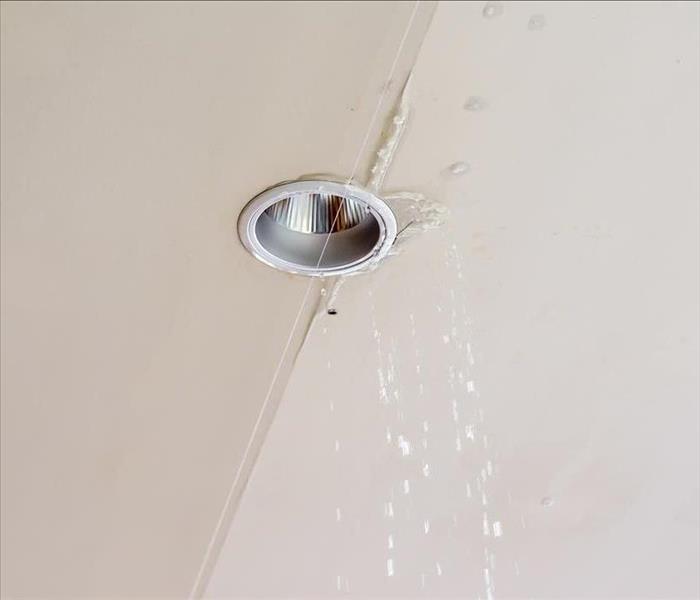 Water in light fixture in an Eau Gallie, FL home
Water in light fixture in an Eau Gallie, FL home
How To Handle Water in Light Fixtures
Often, Eau Gallie, FL, homeowners do not notice a leak until there is already ceiling damage. The first sign of a leak will manifest through the ceiling. You may even see water in the light fixture. If you see this, it’s important that you follow these steps and do not let the water out.
1. Act Quickly
As soon as you see the water in your light, you need to take action. Water serves as a conductor and carries the current wherever the water touches. This means that if a person touches the light socket or attempts to drain it, he or she likely to suffer from an electric shock. It is important that you go straight to the circuit breaker to turn it off.
2. Turn Off the Electricity
Even touching the switch itself can shock you. Do not turn off the light near the fixture. Go to dry electrical source and check the power to make sure that you turned everything off. This will help keep you or anyone else in your family from suffering an accidental shock.
3. Turn Off the Water
Next, turn off the water. This step only works if you know where the source of the water is coming from. If it comes from a pipe, then you can turn off the water supply through the main shutoff valve.
4. Call a Plumber and Electrician
If you have a problem with the pipes, then you need to call for a plumber. The plumber can fix any issues you’re having with the water lines in your home. Next, you need to call an electrician. The electrician will handle the electrical work. Never handle electrical work yourself.
When it comes to water in the light fixtures, you need to act quickly. Often, you’ve already experienced ceiling damage once it’s gotten to this point. Unfortunately, with most ceiling leaks, you will not know that you have a leak until you see the damage. Taking care of the plumbing and electrical work first is important, and then you can call a water damage repair service to take care of water damage.
3 Tips To Quicken the Water Damage Restoration Process
10/5/2018 (Permalink)
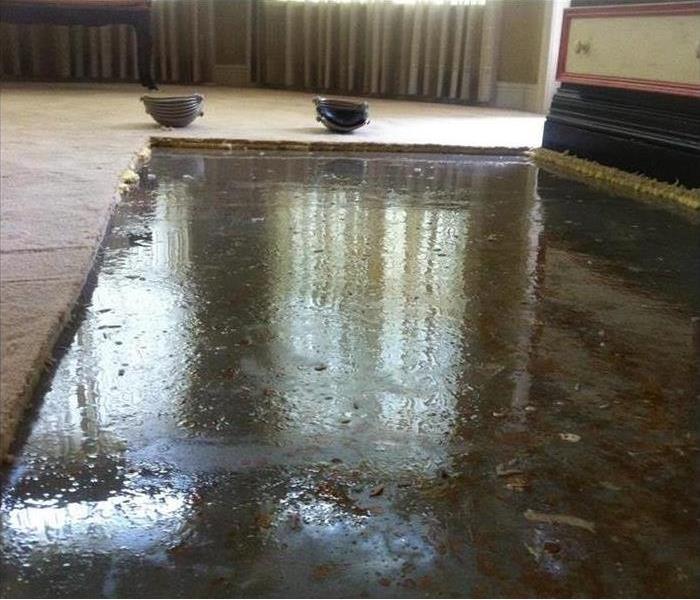 Water damage from flooding in a Melbourne,FL home
Water damage from flooding in a Melbourne,FL home
If you have experienced water damage in your home in Melbourne, FL, you know that the restoration process can seem overwhelming. A pipe burst, or a damaged water line, can quickly lead to your home being flooded. Here are some important steps to keep in mind as you begin the restoration process.
1. Take Precautions
It isn’t always possible to know when you’ll have a burst pipe or a toilet overflow, so taking precautions before water damage occurs can help you protect valuable items in your home. Keep important documents, including birth certificates, contact information and insurance material in water-proof containers.
2. Avoid Hazards
As you start the restoration process, it’s essential to prioritize your safety and the safety of those around you. Depending on the source of the water, there may be pipe burst debris from outside your home that makes cleaning up the water unsafe. Make sure to wear appropriate attire when you enter your home to clean, such as water-resistant shoes and gloves. If you are unsure whether or not your home is safe to be in, it’s probably best not to enter.
3. Act Quickly
As long as it is safe to be in your home, it is important to start the restoration process quickly to prevent excessive damage. Once flooding has occurred, water that sits stagnantly in your home can grow mold and bacteria over time, which can ultimately require more time and money to clean. The sooner you begin to air out your home and remove water, the less damage your house may sustain.
Whether it’s caused by a pipe burst or a flood, water damage can be a common occurrence in many homes. Although there are several ways in which you can make the restoration process move quickly after you’ve experienced water damage, consider contacting professionals in water damage cleanup to ensure your home is as clean and as safe as possible.
When A Home Suffers From Water Damage
9/24/2018 (Permalink)
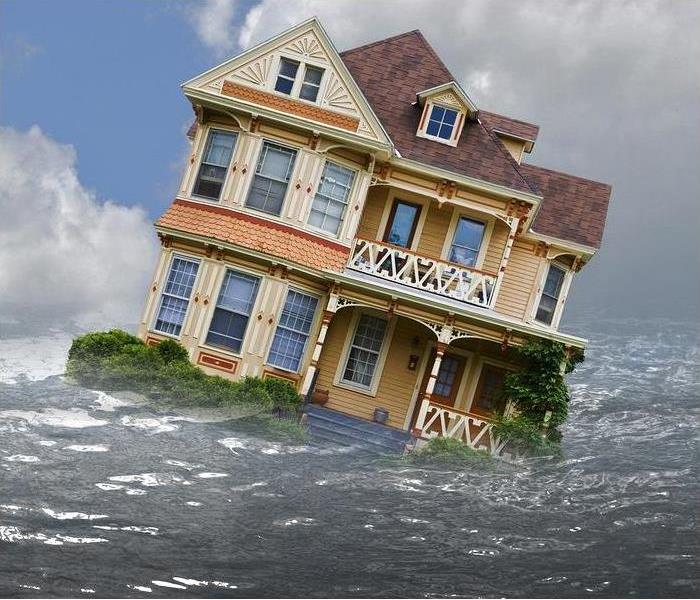 Brevard homes are in good hands when they call SERVPRO of South Brevard.
Brevard homes are in good hands when they call SERVPRO of South Brevard.
Water damage and fire are a homeowner’s worst nightmares. Water damage comes from many sources, and it causes just as much trouble for families as it does for the structure. Dealing with the shock is a little more involved than dealing with the damage. A restoration service can always repair the structure, but who’s going to repair the family? The security that comes from prevention along with flood insurance will give the homeowner less to worry about. These are considerations when a house suffers from water damage.
Consequences
The results of water gushing into the house can affect the family and any pets as well as the structure. Micro-organisms in the water can cause infections when family members come into contact with affected things like carpet or wet furniture. Mold and mildew are responsible for respiratory ailments, nervous system problems like migraine headaches and memory loss. The liver, kidneys and lungs are also seriously affected by mold and mildew. If these things can affect humans so adversely, think what it can do to your pets. They keep their noses to the floor most of the time, where sniffing mold and mildew can cause them to bark, sneeze, itch and get headaches and respiratory problems. The vet might dismiss this as allergies if you don’t tell him about the water damage.
Conclusions
You never know when an emergency will happen causing your home to be inundated. However, checking the walls, baseboards and mouldng for buckling will give alert you to a problem. Get flood insurance. Most homeowners’ policies cover broken appliances and burst pipes in winter. There are several reputable water damage restoration companies in business, one of which will be near you. When you find water damage, remove anything affected including carpet, drywall, insulation and anything in boxes. Put affected belongings in a neutral area to dry, and contact a professional. Check in with the doctor to make sure your family is not adversely affected.
SERVPRO of West Brevard is a 24/7 emergency water removal & flood clean up repair service company, Our technicians are highly trained and experienced with every water damage situation.
Call SERVPRO of West Brevard if you need help with any of our services. Please allow us to be of assistance, give us a call at (386) 447-2202.
Restoring Your Flooded Basement
8/17/2018 (Permalink)
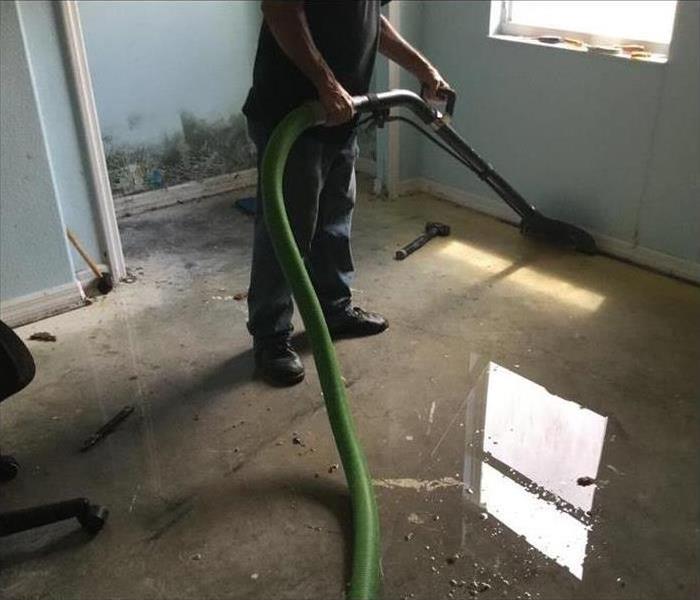 Extraction wand on a water damage in a Melbourne, FL home
Extraction wand on a water damage in a Melbourne, FL home
Restoring your flooded basement in Melbourne, FL, is no easy task, and cleaning up after a basement flood can seem like a hassle. In actuality, with the right equipment and the proper know-how, it can really be quite simple. Plus, there are ample experienced specialists who are ready to help you repair damage and utilize any insurance coverage you may have. Here are a few suggestions to get you started.
Vacuum Up Small Amounts of Water
If you have a dry/wet vacuum at home, you may be able to deal with small problems quickly and easily. If the issue is just an inch or two of water in a manageable area, for example, then you can easily clean it up by using your trusty shop-vac.
Use a Pump for Bigger Issues
If a basement flood starts to rise even further, reaching your shins or even your knees, then you’ll need to bring in some more powerful options. A water pump is a surefire way to get rid of any flooded water and quickly get your basement on track towards what it was before.
You’ll need a submersible pump for jobs like this, something that is surrounded in a protective shell and is able to completely enter the water you’d like to remove. Tie down the pump to something sturdy, and move it once the water begins to shift. Depending on how much water you have to remove, this process likely won't take long at all.
Cleaning Up Once the Water’s Gone
Unfortunately, once you’ve gotten rid of the water, you’ll likely need to replace anything that absorbed it, such as carpets or drywall. A dehumidifier during this step of the process is helpful, but it’s likely you’ll need to remove the drywall entirely in order to combat the damage.
It may seem like the end of the world to find a basement flood in your home, but you won’t run into any trouble if you follow the simple steps above and begin to clean as soon as possible.
Happy Melbourne Customer Writes About Our Services
8/24/2017 (Permalink)
LETTER OF APPRECIATION
On Saturday, August 5th, 2017, we awoke at 5:00 A.M. to water running out of a broken pipe below the sink. We turned off the water and began running a wet-vac to remove what we could of the water. SERVPRO of South Brevard was contacted to take care of the job around 7:30 A.M.
Around 8:30 A.M. Alex Joseph and Shawn arrived, assessed the problem, and began applying necessary corrective measures. This included measurements of affected areas, checking moisture in locations that I would not have checked, placing fans and dehumidifiers, changing fan locations, removing fans and dehumidifiers from areas that were dry. This continued until Tuesday, August 8th, 2017.
Alex and Shawn showed dedication above and beyond "normal" employees, in that they were available and ready to tackle a long job on the weekend on short notice.
Alex showed superior management skills in ensuring the teams time was used to ensure the maximum amount of work done, in the minimum time necessary to accomplish the task at hand. At all points of the job, Alex kept me informed, not only of the progress, but also the projected time needed to complete each phase of the job.
Alex's knowledge and expertise showed in his professionalism and mannerism as the team worked on the job. His general timeline was accurate as well.
Job well done!
Yours Truly,
Ricky C.
Satisfied Customer of Melbourne, FL
Water and Flood Damage: What's the Difference?
11/11/2016 (Permalink)
Water is a necessity, but not when it is causing damage to your home or business. If water damage does occur, SERVPRO of South Brevard can clean and restore your home to make it as though it never happened. However, the cleaning and restoration after damage occurs is not the only piece of the puzzle. When water causes damage, an insurance claim should be made as soon as possible.
Filing an insurance claim because of unwanted water can be complicated. The first step is knowing the difference between a water damage claim and a flood damage. This information is crucial to the policyholder because it determines what is covered and what is not.
The distinction between a water damage claim and a flood damage claim can best be defined by the Federal Emergency Management Agency’s (FEMA) flood definition. According to FEMA, a flood is a general and temporary condition of partial or complete inundation of two or more acres and two or more properties of normally dry land.
To simplify the matter, if the water that caused the damage occurred from a natural source and any neighbors are experiencing the same water issues, it is safe to say the situation is a matter of flooding. According to FEMA, flood damage can only be caused by overflow of inland or tidal waters, unusual and rapid accumulation or runoff of surface waters from any source, mudflow, or collapse of land along the shore of a lake or similar body of water as a result of erosion or undermining caused by waves or currents of water exceeding anticipated cyclical levels that result in a flood.
If a flood has caused damage to your home, it is important to know if you currently have flood insurance through the National Flood Insurance Program, because home insurance companies do not offer coverage on flood damage. Having flood insurance is extremely beneficial to homeowners who think they might even have the slightest chance of being affected by a flood. The official site of the National Flood Insurance Program states that flood insurance policies cover physical damage to your property and possessions.
Everything from the actual building and its foundation to the refrigerator and the food inside of it is covered by flood insurance and will be taken into consideration when claims are filed. Flood insurance does cover basements and areas below the lowest elevated floor, but it depends on the flood zone and the date of construction. It is important to remember that flood insurance does not cover the sentimental value of any property, so be sure to remove any precious items such as photos, documents, or personal items that cannot be replaced as quickly as possible.
When water damage occurs in your home, did not originate from a natural source, and is not affecting any surrounding buildings, a water damage claim is necessary. Circumstances such as overflowing bathtubs, broken toilets, burst water mains, and broken pipes are all grounds for water damage claims that should be filed by contacting your home insurance company.
Working through the process of filing both a water damage claim and a flood damage claim can be tricky and seem overwhelming. SERVPRO offers a Contents Claim Inventory Service for customers who already have enough stress to deal with. What this service does is provide a detailed and accurate list of all of your belongings. Our Technicians have the experience needed to deliver detailed and accurate reports to insurance companies and help settle claims fast.
If you are experiencing either water or flood damage in your home, SERVPRO of South Brevard can inspect the damage, remove the moisture, and make repairs using state of the art extraction equipment as quickly as possible.
It is important to take immediate action when it comes to both water and flood damage. Refer to our Water Damage Emergency Tips and keep safety as your primary focus. Do not fret, SERVPRO has the ability and resources to go beyond just basic restoration by repairing electronics such as televisions and computers and also dry photographs and documents. Highly trained Water Restoration Technicians are available around the clock for when damage occurs and are only a phone call away.
5 Ways to Spot Water Damage to Your Foundation
10/19/2016 (Permalink)
One of the most serious issues that can be caused by water damage is water getting into the foundation. This has the potential to cause many structural issues to the house. Some of these structural issues can be quite easy to see but others can be quite difficult to see. No matter how easy these problems are to spot, noticing them early will make fixing the issue easier and cheaper than if they are found later on. Here are five tips to spotting water damage to your foundation that will save you time and money.
Wet Soil Around the House
If the soil around the house is very wet, this is a sign that the water around the house is not draining as it should. If water is standing around the house, it has the ability to seep into the foundation. When water gathers at the foundation of the home, this has the ability to cause serious structural issues to the house.
Wet Crawl Space
If your home has a crawl space, an area that has limited height and is typically used for electrical wiring, this space is often vulnerable to water damage. You can tell that water has infiltrated the crawl space and is causing trouble as there will be moisture, standing water, or staining within the crawl space. If this crawl space is underneath your floors, this is caused by water that has seeped into the foundation of the home. If this crawl space is in your attic, that means you likely have a leak in your roof somewhere. Either way, this is a problem that must be rectified to avoid worse water damage throughout the home and to restore the structural stability of the home.
Uneven Floors
The floors in your home should be straight and level with the foundation of the house. If there happens to be any deviation in the levelness of the floors, that shows that there are issues with the foundation. It doesn’t necessarily mean that there is water damage within the foundation, but that certainly could be the issue. Any issues with floors can be difficult to tell so if you think water may have infiltrated your foundation, you might want to consider bringing out the leveler to check how level your floors are. The change might be very small and only noticeable using a leveler.
Appearance of Discoloration or Mildew Outside of the House
Water that is properly draining from your house shouldn’t be standing next to your house long enough that it can cause stains and mildew. If stains or mildew are being caused by standing water, that water is probably there long enough to drain into the foundation of the home. Additionally, any issues like mold or mildew, which is caused by the existence of moisture, that accumulates near your home can cause health issues for your family, especially if anyone in your home suffers from asthma or respiratory problems.
Your Doors Are Not Working Properly
If you have a door that was working fine but now is sticking or jamming, it may be because the wood of the doorframe is warped. Water is often the cause of wood warping. This could be that water has accumulated around the door and has caused water damage. But another, and more severe issue, could be that water has gotten into the foundation of the home and has caused the warping of the wood. If it is water damage as opposed to foundation damage, it may also cause problems to windows around the house which could make it difficult to open and close them as the wood around the window warps.
Damage to the foundation of your home is a serious matter. The foundation is set to create a safe and stable home for your family. But if water gets into the foundation, it has the ability to create several issues including the warping of wood around door frames and making floors uneven. The most severe issue it can cause is problems to the stability of the home. The longer water sits in any place, the more damage it can cause. So if you have any sort of water damage around your home, it’s important that you contact the professionals at SERVPRO immediately to ensure that the problem doesn’t become worse.
Top 5 Causes of Home Water Damage
9/26/2016 (Permalink)
Water damage is one of the worst fears for a homeowner. Just a little bit of water can create a significant amount of damage to your home. Whether a leak or some other problem, it is important to have any amount of water damage cleaned up as soon as possible as irreparable damage can occur within 48 hours of the initial incident.
Recently, the Insurance Institute for Business and Home Safety (IBHS) conducted a study using insurance claims to identify what the leading causes of water damage were. These are the top five causes of water damage and what you can do to avoid such a fate.
Plumbing Supply
A failure to your plumbing supply system has the ability to cost you about $5,000 after your insurance deductible. Indicators of such a problem include an increase in your monthly water bill, banging pipes, rust stains, moisture in the walls or the floors, and signs of wet soil erosion near the foundation. You can take steps to avoid such a problem by ensuring that your pipes will not freeze during the cold winter months. To keep your pipes from freezing in the cold, set your thermostat at 60 degrees, let your faucets drip to get the water out of your pipes, and insulate your pipes to keep them warm. Additionally, you can install a house leak detection system that will alert you should there be a leak in your home.
Toilet
One of the most common sources of water damage is a toilet failure and one-third of toilet failures are caused by overflowing or a clogged toilet. After taking out the deductible, water damage due to toilet failure typically cost more than $5,500. To avoid a toilet failure in your home, wait until the valve has finished refilling the tank and bowl after flushing. If it looks as though an overflow might be coming, turn off the supply valve to avoid the water spilling out. Another way to prevent toilet failure is to inspect your toilet’s components twice a year. This inspection should include the supply valve, the flush valve, and the supply line. While you’re at it, you might want to consider upgrading your toilet’s supply line to a sturdier braided steel hose.
Water Heater
Most water heater failures are caused by a slow leak or a sudden burst in the tank. The next common cause of water heater failures is due to the supply line. Checking the life expectancy and warranty for your water heater will tell you whether or not you need to replace your water heater. To increase the life expectancy and delay replacing your water heater, perform proper maintenance. This includes flushing sediments and inspecting your heater’s anode rod. Inspecting the water heater’s valves will ensure that they are all in proper working order. Whenever possible, you should use ball valves instead of gate valves which will improve its working condition.
Plumbing Drain
Sewer backups are at fault for more than half of plumbing system failures with the majority of these issues occurring in the southern states. Problems with the plumbing drain system run at an average cost of $4,000 per incident after the insurance deductible. With that type of cost per incident, homeowners will want to do what they can to prevent such an event. The easiest way to prevent these problems is by refraining from pouring grease down the drain. Another way you can prevent sewer problems is by installing a backflow prevention assembly for the home’s sewer system if the home’s sewer system is connected to the city’s system. This is generally a problem for older homes. If you are considering planting trees, doing so away from lateral drain lines will ensure that the roots don’t end up damaging any piping.
Washing Machines
Washing machine hose failures are at fault for more than half of claims that the IBHS study recorded. The average cost to the homeowner after their insurance deductible came to $5,300 per incident. The reason why these incidents are so troublesome is that a burst inlet hose can cause an entire laundry room to flood in just a matter of minutes. To avoid this occurring, it’s recommended that you replace the rubber hoses every three years. If you want to go a step further, you can replace the rubber hoses with braided steel hoses. Other tips include turning off the hot and cold water supply valve when you leave the house and not overloading the machine.
Water damage can be a devastating and costly event for a homeowner. These tips will help you avoid the potential troubles that come with water damage. If you do suffer from water damage in your home, call on the professionals at SERVPRO for a quality restoration.






 24/7 Emergency Service
24/7 Emergency Service
